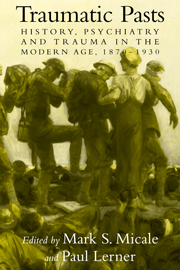Book contents
- Frontmatter
- Contents
- Contributors
- Preface
- 1 Trauma, Psychiatry, and History: A Conceptual and Historiographical Introduction
- Part One Travel and Trauma in the Victorian Era
- Part Two Work, Accidents, and Trauma in the Early Welfare State
- Part Three Theorizing Trauma: Psychiatry and Modernity at the Turn of the Century
- Part Four Shock, Trauma, and Psychiatry in the First World War
- 9 “Why Are They Not Cured?” British Shellshock Treatment During the Great War
- 10 Psychiatrists, Soldiers, and Officers in Italy During the Great War
- 11 A Battle of Nerves: Hysteria and Its Treatments in France During World War I
- 12 Invisible Wounds: The American Legion, Shell-Shocked Veterans, and American Society, 1919–1924
- Index
- Titles in the series
11 - A Battle of Nerves: Hysteria and Its Treatments in France During World War I
Published online by Cambridge University Press: 14 October 2009
- Frontmatter
- Contents
- Contributors
- Preface
- 1 Trauma, Psychiatry, and History: A Conceptual and Historiographical Introduction
- Part One Travel and Trauma in the Victorian Era
- Part Two Work, Accidents, and Trauma in the Early Welfare State
- Part Three Theorizing Trauma: Psychiatry and Modernity at the Turn of the Century
- Part Four Shock, Trauma, and Psychiatry in the First World War
- 9 “Why Are They Not Cured?” British Shellshock Treatment During the Great War
- 10 Psychiatrists, Soldiers, and Officers in Italy During the Great War
- 11 A Battle of Nerves: Hysteria and Its Treatments in France During World War I
- 12 Invisible Wounds: The American Legion, Shell-Shocked Veterans, and American Society, 1919–1924
- Index
- Titles in the series
Summary
According to the official story published by the French army's health service in 1918, psychological trauma (or “war hysteria”) among French soldiers in 1914–1918 was a marginal phenomenon. The report, titled “Science and Duty,” expressed a manichean view of the mental performance of French soldiers. On the whole, it maintained, the army had behaved heroically: “In this war, unique in its accumulation of conditions for moral exhaustion, our generation has shown a truly marvelous mental and nervous resiliency [resistance].” At the same time, however, it admitted that “war hysterics were the sores of the neuro-psychiatric centers.” While acknowledging that the war produced “numerous hysterical accidents,” it dismissed illnesses of this category as artificial and perverse. So far from winning admission to the heroic ranks of the war wounded, hysterics were scapegoated as the antithesis of the resilient poilu. Their problems amounted to “false pathological syndromes, … artificial creations …, fabulations, and mythical stories [romans mensongers].” Rather than victims, they were “mythomaniacs” who had fallen under the influence of “various motives such as vanity, cupidity, eroticism, etc.”
Even in its most triumphalist text, the Service de Santé trivialized trauma, but could not deny it. The percentage of patients assigned to neurological centers for “hysterical,” “hystero-traumatic,” or “functional” symptoms had, according to the archives of the same institution, exceeded ten percent in every region of France, and in some areas rose to fifty and sixty percent.
- Type
- Chapter
- Information
- Traumatic PastsHistory, Psychiatry, and Trauma in the Modern Age, 1870–1930, pp. 253 - 279Publisher: Cambridge University PressPrint publication year: 2001
- 13
- Cited by

